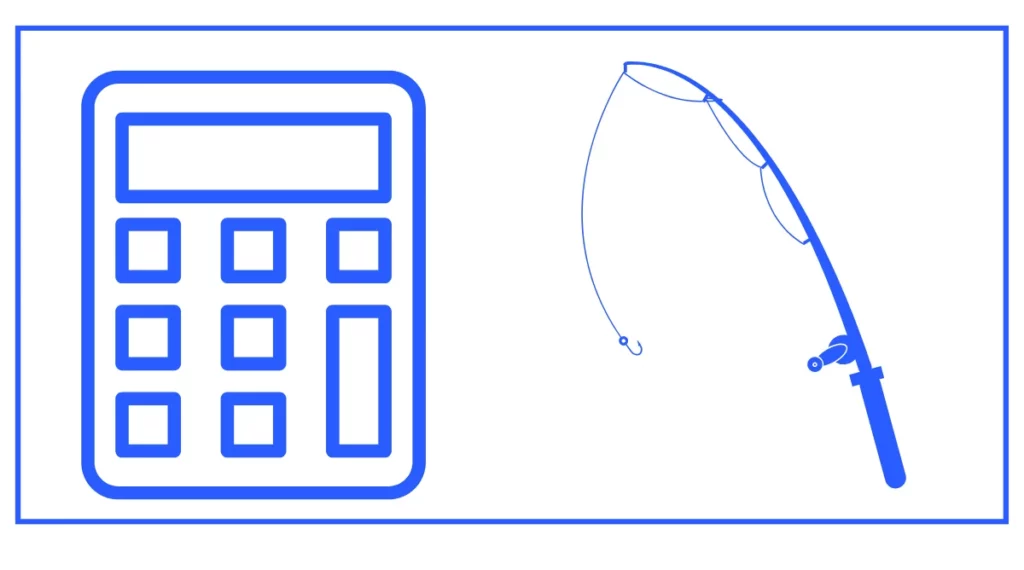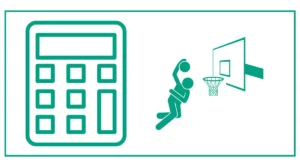Fishing Reel Line Capacity Calculator
Do you need help figuring out how much fishing line your reel can hold?
The fishing reel capacity calculator can calculate the line capacity for all types of reels: spinning, spin cast, fly, and bait cast.
It is easy to use and will help you make sure you have the right amount of line for your next fishing trip.

Simply enter the published line diameter and length, and the diameter of the new reel.
You might want to calculate the fish weight.
What is a Fishing Reel Line Capacity Calculator?
A fishing reel line capacity calculator is a specialized tool designed to help anglers determine how much fishing line can fit on their reel. This calculator takes into account various factors such as the diameter of the line and the physical dimensions of the reel’s spool to provide an accurate estimate of line capacity. By using this tool, fishermen can make informed decisions about line selection and ensure they have the right amount of line for their specific fishing needs.
Why is Reel Line Capacity Important?
Understanding reel line capacity is crucial for several reasons:
- Proper line selection: Knowing your reel’s capacity helps you choose the right type and amount of line for your fishing style and target species.
- casting distance: The amount of line on your reel can affect your casting distance and accuracy.
- Fish fighting ability: Having the right amount of line ensures you have enough to play and land large fish.
- Tackle balance: Matching your line capacity to your rod and reel setup creates a well-balanced fishing system.
How to Use a Fishing Reel Line Capacity Calculator
Using a fishing reel line capacity calculator is a straightforward process. Here’s a step-by-step guide:
- Gather information: You’ll need to know the published line capacity of your reel for a specific line diameter and length. This information is usually provided by the reel manufacturer.
- Enter the data: Input the line diameter and length from the published capacity into the calculator.
- Specify new line: Enter the diameter of the new line you wish to use.
- Calculate: The tool will then calculate and display the estimated length of the new line that will fit on your reel.
For example, let’s say your reel’s published capacity is 200 yards of 10 lb monofilament line with a diameter of 0.30 mm. If you want to use a 12 lb line with a diameter of 0.33 mm, the calculator will determine how many yards of this new line will fit on your reel.
The Mathematics Behind Reel Line Capacity
Understanding the formula used in a fishing reel line capacity calculator can help you appreciate the tool’s accuracy and reliability. The basic principle relies on the fact that the volume of line that can fit on a spool remains constant, regardless of the line’s diameter.
The formula used is:
(Old Line Diameter^2 * Old Line Length) / (New Line Diameter^2) = New Line LengthThis formula assumes that the lines are wound uniformly and that the spool is a perfect cylinder. While real-world conditions may introduce some variations, this calculation provides a reliable estimate for most practical purposes.
Factors Affecting Reel Line Capacity
Several factors can affect the actual line capacity of a fishing reel:
- Line type: Different types of line (monofilament, fluorocarbon, braided) have varying diameters and compressibility, which can affect how much fits on a spool.
- Line tension: How tightly the line is wound onto the spool can impact capacity. Loose winding may result in less line, while tight winding can increase capacity.
- Spool shape: The shape of the spool, including any tapers or irregularities, can affect line capacity.
- Line memory: Some lines, particularly monofilament, can develop “memory” and take up more space on the spool over time.
- Backing: If you’re using backing on your reel, this will reduce the capacity available for your main line.
Benefits of Using a Line Capacity Calculator
Employing a fishing reel line capacity calculator offers several advantages:
- Accuracy: It provides a more precise estimate than guesswork or rough calculations.
- Time-saving: Quickly determine line capacity without trial and error or manual measurements.
- Cost-effective: Avoid purchasing too much or too little line for your reel.
- Versatility: Easily compare different line options for your reel.
- Improved fishing experience: Ensure you have the right amount of line for your target species and fishing technique.
Common Scenarios for Using a Reel Line Capacity Calculator
Here are some typical situations where a fishing reel line capacity calculator proves particularly useful:
Switching Line Types
Many anglers switch between different types of line depending on the fishing conditions or target species. For instance, you might want to change from a 12 lb monofilament to a 30 lb braided line. The calculator can help you determine how much of the new line will fit on your reel.
Upgrading Fishing Gear
When purchasing a new reel, you can use the calculator to determine if it will hold enough of your preferred line for your fishing needs. This is especially important when transitioning between different types or sizes of reels.
Tournament Preparation
In competitive fishing, having the right amount of line can be crucial. A line capacity calculator can help anglers optimize their setup for specific tournament conditions.
Deep Sea Fishing
Offshore anglers often need substantial amounts of line. The calculator can help ensure they have enough line for deep-water trolling or bottom fishing.
Tips for Maximizing Reel Line Capacity
To get the most out of your reel’s line capacity, consider these tips:
- Use braided line: Braided lines have a smaller diameter for their strength, allowing you to fit more line on your reel.
- Wind line tightly: Ensure your line is wound onto the spool under consistent tension for maximum capacity.
- Fill to the appropriate level: Don’t overfill your spool, as this can lead to tangles and reduced casting performance.
- Consider backing: Use backing to fill the spool partially before adding your main line, especially with expensive lines.
- Maintain your reel: Regular cleaning and maintenance can prevent issues that might affect line capacity.
Limitations of Line Capacity Calculators
While fishing reel line capacity calculators are incredibly useful, it’s important to understand their limitations:
- Estimates, not exact measurements: The results are approximations based on ideal conditions.
- Variations in line diameter: Actual line diameters may vary slightly from manufacturer specifications.
- Spool irregularities: The calculator assumes a perfectly cylindrical spool, which may not always be the case.
- User error: Incorrect input of data can lead to inaccurate results.
- Line compression: The calculator doesn’t account for how some lines may compress more than others when wound onto a spool.
Frequently Asked Questions
How do I find my reel’s published line capacity?
The published line capacity is usually printed on the reel itself or included in the manufacturer’s specifications. It’s typically expressed as a certain length of line at a specific pound test (e.g., 200 yards of 10 lb test).
Can I mix line types on my reel?
Yes, many anglers use a combination of backing and main line. The line capacity calculator can help you determine how much of each type will fit.
How does line capacity affect casting distance?
Generally, a fuller spool allows for longer casts. However, overfilling can lead to tangles and reduced performance.
Does line capacity matter for all types of fishing?
While line capacity is important for all fishing, it’s particularly crucial for techniques that require long casts or deep water fishing where you need a lot of line.





